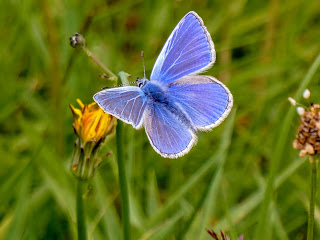Stuart's Wildlife Diary
Monday, 30 June 2025
Moths
Monday, 23 June 2025
Dusk Birding and More Butterflies
It was a beautiful evening on Tuesday 17th June as I headed up to the edge of Dartmoor to meet Mavis and Kay for a Nightjar walk. There was only a little breeze and it felt quite warm although it cooled down quickly as dusk fell, the skies were mostly clear too but the bits of cloud present made for a beautiful sunset. It was lovely to have Mike join us too and we all kept our fingers crossed for some Nightjar action.
Myself, Mavis and Kay set off for a walk while Mike stayed in the car and we managed to find a few birds in the fading light, the best being a Spotted Flycatcher flitting about between Hawthorn bushes before disappearing from view. Stonechats, Meadow Pipits and Linnets were vocal and showy too while Willow Warblers were melodiously singing away.
We headed back to the car and drove over to another car park to set ourselves up for the Nightjars as the light continued to fall. We could hear a very distant Cuckoo calling while Kay sadly found a dead Slow Worm on the footpath, my second one of the year. A male Yellowhammer was seen perched up on top of a bush and a group of Fallow Deer showed nicely as they crossed the road, skillfully avoiding the frequent cars passing by.
As we were scanning about I caught sight of a distant white bird flying over the Down, at first I thought it was a Little Egret (!) before realising it was in fact a Barn Owl! We watched it for a while as it quartered over the ground, it occassionally hovered and dived down into the vegetation although it never appeared to catch anything. It eventually drifted off out of sight but I was pleased to have seen only my second ever Devon Barn Owl, an unexpected and very delightful surprise.
Eventually we heard a Nightjar churring, a strange and wonderful sound, it sang away for a good 30 minutes as it moved position around the Down but unfortunately we never got a view of it and no other males were heard either. The light eventually went and it was time to leave with Kay very kindly dropping me off closer to civilisation so I could catch a bus home. It had a been a very enjoyable evening indeed despite the lack of a Nightjar sighting but listening to their churring song is always a special treat.
With the weather beginning to heat up I headed out to Wembury for a walk on Thursday 19th June, I arrived off the bus at around 9:45am and it was already very hot in the strong sunshine and there was very little breeze to cool things down. I was on the lookout for butterflies again so didn't pay much attention to bird life, there wasn't much to see anyway and I didnt even find any Oystercatchers or Stonechats on my walk which is very unusual but there were Chiffchaffs, Blackcaps, Whitethroats and Cirl Buntings singing away and I also briefly heard a Cetti's Warbler in the valley to the beach. I was pleased to see 2 Swifts hawking insects over the village amongst the House Martins as I passed by on the bus and the only other sightings of note were 2 Little Egret and a female Mallard along the beach.
I did find some butterflies though with sightings of my first Small Skippers and Ringlets of the year along with 2 Green Hairstreak, a Common Blue, a Painted Lady, 2 Red Admiral, Large Skippers, Meadow Browns and Commas.
I stepped off the bus at Morrisons on the journey home from Wembury to meet up with Mavis and Kay to look for the Oreston Hairstreaks. It was baking hot by now but quite breezy and the tree tops were swaying away making viewing difficult but we did find White-letter Hairstreaks flitting about and I also managed a brief view of a Purple Hairstreak, making it a rare 3 Hairstreak day. To finish off we had a look at the nearby Bee and Pyramidal Orchids before heading home, I'd had a great time but was very glad to get indoors and out of the heat.


















